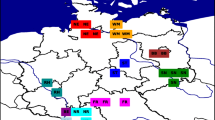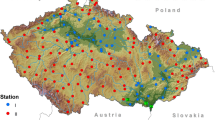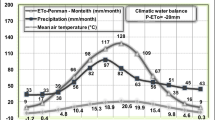Abstract
This paper demonstrates the use of climatological data and published information to develop a thaw-freeze/freeze-kill indicator for fruit trees during flowering. In fruit-producing regions, when budding and flowering occur before the last spring freeze, a freeze-kill event can cause substantial losses. As spring onset is occurring earlier with climate change, thaw-freeze events have the potential to become more of a hazard both in terms of current production and in terms of potential adaptation strategies. To model the spring thaw-freeze and its magnitude or intensity, we proposed an indicator based on the accumulation of daily minimum temperature between successive freezing dates and its maximum value over the spring. This indicator was tested on apple and peach production in southern Ontario, Canada, using data from eight climate stations in southern Ontario. The indicator showed promise in its utility in that its magnitude was greater when freezing occurred after blooming and it was demonstrated to be correlated to the estimated blooming dates of apple and peach fruits grown in southern Ontario. The annual series was shown to fit the generalized extreme value distribution thereby allowing the extreme risk to be modelled and the return period to be calculated. It was also shown that the reported thaw-freeze events that caused significant apple and peach losses had a return period on the order of 10 years.










Similar content being viewed by others
Data availability
All data are publicly accessible and methods of analysis and software are described in the manuscript.
References
Anderson JL, Richardson EA, Kesner CD (1986) Validation of chill unit and flower bud phenology models for ‘Montmorency’ sour cherry. Acta Hortic 184:71–78
Baier W, Desjardins RL, Ouellet CE, Williams GDV (1976) Recent biometeorological applications to crops. Int J Biometeorol 20(2):108–127
Balandier P, Bonhomme M, Rageau R, Captain F, Parisot E (1993) Leaf bud endodormancy release in peach trees: evaluation of temperature models in temperate and tropical climate. Agric Forest Meteorol 67(1-2):95–113. https://doi.org/10.1016/0168-1923(93)90052-J
Caprio JM, Quamme HA (1999) Weather conditions associated with apple production in the Okanagan Valley of British Columbia. Can J Plant Sci 79:129–137
Faust E, Herbold J (2018) Spring frost losses and climate change – not a contradiction in terms, Munich RE, January 29, 2018, https://wwwmunichrecom/topics-online/en/climate-change-and-natural-disasters/climate-change/spring-frost-losses-climate-change-2018html. Accessed 30 Oct 2020.
Faust M, Erez A, Rowland LJ, Wand SY, Norman HA (1997) Bud dormancy in perennial fruit trees: physiological basis for dormancy induction, maintenance and release. HortScience 32(4):623–629. https://doi.org/10.21273/HORTSCI.32.4.623
Fishman S, Erez A, Couvillon GA (1987) The temperature dependence of dormancy breaking in plants - computer simulation of processes studied under controlled temperatures. J Theoretical Biol 126(3):309–321
Funes I, Aranda X, Biel C, Carbo J, Camps F, Molina AJ, de Herralde F, Grau B, Save R (2016) Future climate change impacts on apple flowering date in a Mediterranean subbasin. Agric Water Manag 164:19–27. https://doi.org/10.1016/j.agwat.2015.06.013
Gilleland E (2018) Package ismev: An introduction to statistical modeling of extreme values 142. https://cran.r-project.org/package=ismev. Accessed 22 Oct 2019
Government of Canada (2019) Historical climate data, https://climate.weather.gc.ca/historical_data/search_historic_data_e.html. Accessed 20 March 2019
Guak S, Neilsen D (2013) Chill Unit models for predicting dormancy completion of floral buds in apple and sweet cherry, Horticulture. Environ Biotechnol 54(1):29–36. https://doi.org/10.1007/s13580-013-0140-9
Hayhoe K, Wake CP, Huntington TG, Luo L, Schwartz MD, Sheffield J, Wood E, Anderson B, Bradbury J, DeGaetano A, Troy TJ, Wolfe D (2007) Past and future changes in climate and hydrological indicators in the US Northeast. Clim Dyn 28:381–407. https://doi.org/10.1007/s00382-006-0187-8
Higgins A (2019) Climate change is already hurting fruit breeders, and consumers could soon feel the pain, Washington Post, March 28, 2019, https://wwwwashingtonpostcom/lifestyle/home/climate-change-is-already-hurting-fruit-breeders-and-consumers-could-soon-feel-the-pain/2019/03/27/6d5252fa-36c2-11e9-854a-7a14d7fec96a_storyhtml accessed 30 Oct 2020.
Luedeling E (2019) Package chillR: statistical methods for phenology analysis in temperate fruit trees, R package v 0.70.21.3, 2019-11-21, personal communication. The latest version can be accessed at: https://cran.r-project.org/package=chillR
Luedeling E, Kunz A, Blanke MM (2013) Identification of chilling and heat requirements of cherry trees - a statistical approach. Int J Biometeorol 57:679–689. https://doi.org/10.1007/s00484-012-0594-y
OMAFRA (2019a) Area, production and farm value by county, Apples 2002-2017, http://www.omafra.gov.on.ca/english/stats/hort/ctyapple.xls Accessed 4 Mar 2019
OMAFRA (2019b) Area, production and farm value by county, Peaches 2002-2017, http://www.omafra.gov.on.ca/english/stats/hort/ctypeach.xls Accessed 27 Nov 2019
Ontario Apple Growers (2013) Annual report October 31, 2013, 35 pp. http://onapples.com/uploads/images/files/Annual-Report-2013-final.pdf. Accessed 18 Mar 2019
Ontario Apple Growers (2015) Annual report October 31, 2015, 36 pp. http://onapples.com/uploads/images/files/OAGAnnualReportFINALnoFS-2015.pdf. Accessed 18 Mar 2019
Ontario Tender Fruit Growers (2016) Annual report and financials for the year ending January 31st, 2016, pp 30.
Ontario Tender Fruit Producers’ Marketing Board (2014) 35th Annual report and financial statements for the year ending January 31st, 2014, 29 pp. http://www.ontariotenderfruit.ca/uploads/file/2013-Tender-Fruit-Final-with-Financials.pdf. Accessed 6 Mar 2019
Palmer JW, Prive JP, Tustin DS, (2003) Chapter 10 Temperature in Apples: botany, production and uses, eds Ferree D.C. and Warrington I.J. CAB International, CABI Publishing, Wallingford, Oxon, U.K. and Cambridge MA, USA, pp 217–236
R Core Team (2019) R: A language and environment for statistical computing. R Foundation for Statistical Computing, Vienna, Austria. URL https://www.R-project.org/
Razavi F, Hajilou J, Tabatabaei SJ, Dadpour MR (2011) Comparison of chilling and heat requirements in some peach and apricot cultivars. Res Plant Biol 1(2):40–47
Rea R, Eccel E (2006) Phenological models for blooming of apple in a mountainous region. Int J Biometeorol 51:1–16. https://doi.org/10.1007/s00484-006-0043-x
Richardson EA, Seeley SD, Walker DR (1974) A model for estimating the completion of rest for Redhaven and Elberta peach trees. HortScience 9(4):331–332
Sanders-DeMott R, Sorensen PO, Reinmann AB, Templer PH (2018) Growing season warming and winter freeze–thaw cycles reduce root nitrogen uptake capacity and increase soil solution nitrogen in a northern forest ecosystem. Biogeochemistry 137:337–349. https://doi.org/10.1007/s10533-018-0422-5
Schwartz MD (1993) Assessing the onset of spring: a climatological perspective. Phys Geogr 14(6):536–550. https://doi.org/10.1080/02723646.1993.10642496
Schwartz MD, Ahas R, Aasa A (2006) Onset of spring starting earlier across the Northern Hemisphere. Glob Chang Biol 12:343–351. https://doi.org/10.1111/j.1365-2486.2005.01097.x
Tharaga PC (2014) Impacts of climate change on accumulated chill units at selected fruit production sites in South Africa, M.Sc. Agrometeorology Thesis, Dept. Soil, Crop and Climate Sciences, Faculty of Natural and Agricultural Sciences, Univ. of the Free State, pp 115. https://pdfs.semanticscholar.org/0110/19c7842cb9713b4dfd40ee547ecf0e145a3b.pdf. Accessed 24 Oct 2019
Valentini N, Me G, Spanna F, Lovisetto M (2004) Chilling and heat requirement in apricot and peach varieties. Acta Horticulturae 636:199–2003. https://doi.org/10.17660/ActaHortic.2004.636.24
Vincent LA, Gullet DW (1999) Canadian historical and homogenous temperature datasets for climate change analysis. Int J Climatol 19:1375–1388
Weinberger JH (1950) Chilling requirements of peach varieties. Proc Amer Soc Hort Sci 56:122–128
Acknowledgements
We would like to thank Dr. Eike Luedeling of the Institute of Crop Sciences and Resource Conservation, University of Bonn, Germany, for his personal attention in modifying his plant phenology model chillR for this study.
Funding
Not applicable.
Author information
Authors and Affiliations
Contributions
Both authors, S. Kaharabata and R. Desjardins contributed to the body of work presented. Conceptualization of the work was done by both authors. Data collection and analysis were performed by S. Kaharabata. The first draft of the manuscript was written by S. Kaharabata and subsequent revisions made by R. Desjardins and S. Kaharabata. All authors read and approved the final manuscript.
Ethics declarations
Competing interests
The authors declare that they have no competing interests. The authors have no conflicts of interest to declare that are relevant to the content of this article. Partial financial support was received from the Sustainability Metric Project of the Science and Technology Branch of Agriculture and Agri-Food Canada.
Code availability
R packages noted in the manuscript were used to analyse data and then further explored and visualized using Excel.
Additional information
Publisher’s note
Springer Nature remains neutral with regard to jurisdictional claims in published maps and institutional affiliations.
Rights and permissions
About this article
Cite this article
Kaharabata, S., Desjardins, R.L. An indicator of freeze-kill damages to fruit trees during flowering. Int J Biometeorol 65, 813–825 (2021). https://doi.org/10.1007/s00484-020-02055-z
Received:
Revised:
Accepted:
Published:
Issue Date:
DOI: https://doi.org/10.1007/s00484-020-02055-z




